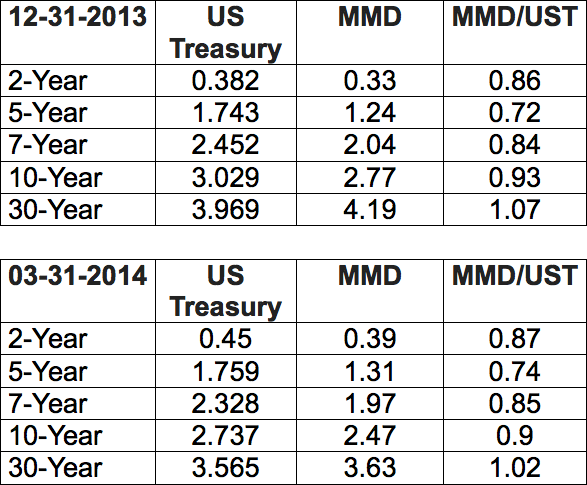The last few weeks have seen a very decent drop in intermediate- and longer-term tax-free bond yields. This year’s stable muni market is very different from that of a year ago, when the great meltdown ensued from bond fund selling fomented by fears of Federal Reserve tapering of quantitative easing. The charts below, comparing long US Treasury yields and Municipal Market Data AAA tax-free yields, tell the story.



Last summer’s SHARP rise in long muni yields has been mostly reversed. Long tax-free yields are now down more than 100 basis points since the peak of the carnage last September whereas long Treasury yields have only declined by roughly 40 basis points.
More importantly, the entire high-grade municipal bond yield curve is now BELOW that of Treasuries – in shorter maturities it is SIGNIFICANTLY below. A year ago the entire curve was ABOVE Treasuries – a condition that probably points more to an overbought US Treasury market than to the innate cheapness of the muni market.
A number of factors have contributed to the healing:
Greater demand. Not only have bond fund flows turned positive – in stark contrast to the hemorrhaging last summer – but higher marginal tax rates have finally affected investors. In many cases, between higher federal rates and the Obamacare tax on interest income, the highest-income taxpayers are facing a marginal tax rate of 43.4% (for calculation of taxable equivalent yield value of munis) versus 35% in 2012. In addition, we believe that there has been some reallocation from equities to bonds in general since the start of the year.
Smaller supply. New-issue supply is down approximately 25% year to date. There is no question that issuers are still acting in an austere manner post-financial crisis. Bond issues are not approved at anywhere near the rate that they were approved prior to the financial crisis.
Better story on credit. Apart from Puerto Rico and Detroit, most municipalities are faring better. Revenue bonds continue to enjoy higher debt-service coverage numbers as the economy continues to recover, albeit slowly. And property-tax-based bonds have benefitted from the rebound in many housing markets.
Economic numbers that did not support higher yields. For all the sound and fury over rising yields in the bond market last summer, almost none of the traditional reasons for higher yields materialized. Inflation is lower, real GDP lower, unemployment lower but shadowed by a continuing decline in the labor participation rate.
Fear of tapering was worse than tapering. Once the Fed actually started tapering in December, investors realized that it was not the end of the world. In fact, the tapering was validation that the Fed’s quantitative easing programs have lacked efficacy and that lending by banks has not measurably increased.
The change in the TONE of the muni market is dramatic. There were numerous times during the carnage of summer 2013 when many blocks of bonds received no bids. Cumberland itself experienced this as we worked to BUY cheap bonds last summer. Often we were told that we were the ONLY bid on a block of bonds – often they didn’t trade – but when they did, they were CHEAP. Today there are multiple bids on almost all blocks of bonds, and even odd lots are receiving good bids. Bond deals come to market and are oversubscribed many times over.
Where to go from here?
At Cumberland we have spent the last couple of months actually reducing the average maturities and durations of accounts. Some of this transitioning has occurred naturally as yields have fallen and many bonds are yielding to shorter call dates; therefore the duration of these bonds is somewhat self-shortening. But we have also actively reduced some of the longer bonds, as there is a big difference between 5%+ yields and yields of 4% or less. Thus we have devoted some portions of portfolios to cash, floaters, or very-short-term bonds. As last summer demonstrated, it doesn’t take much for folks to get nervous and start behaving as a herd. We would like to have some ammunition when that day comes again.
We expect muni supply to increase measurably from present levels as we reach the end of this year. There were many longer-maturity bond issues sold in 2005 and 2006 that carried 10-year calls and sported coupons of 5% or higher. Many of these issues will be callable on a current basis over the next couple of years, saving issuers 100 basis points at current levels.
And inflation, though contained, has started to show some rise. The CPI was up 2% in April and the number of components increasing were nearly double those of the no change or declining variety. We do not see any wage pressures on inflation because of decline in the labor participation rate. It is generally thought that if that rate stabilizes or moves up, the transmission of higher wages to the general inflation numbers will become more acute, However, the real risk is that a change in policy and an increase in rates, because of the importance of interest rates in the CPI may mean an accelerating inflation environment. Wages may increase simply reflecting gains in productivity and tell us nothing about inflation. We do not feel that this minor increase in inflation means a rise in long-term, secular interest rates. It DOES mean that we do not want to leave all of the appreciation in the bond market this year on the table.
John Mousseau, CFA, Executive Vice President & Director of Fixed Income.
